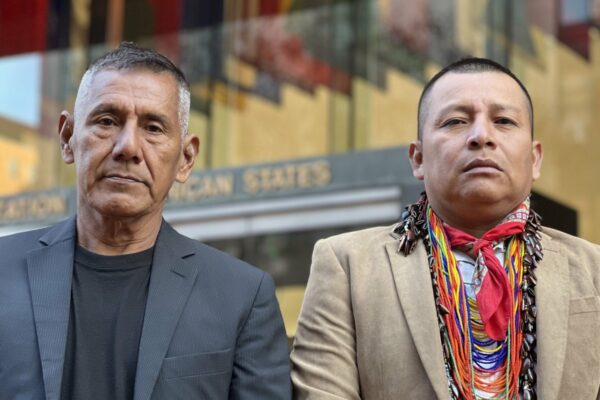After years of waiting for the Brazilian government to sort out their land rights, the 13,000 Munduruku Indians, who live beside the Tapajós river in the heart of the Brazilian Amazon, have decided to take action. Besides temporarily occupying an office belonging to Funai, the Brazilian government’s Indian agency, they have started to demarcate the boundaries of the land they claim.
The dispute is over one of their main areas – a territory of 178,000 hectares (440,000 acres) around the village of Sawré Muybu. Funai promised them rights to this land 13 years ago.Juarez Saw, the cacique (chief) of Sawré Muybu, said: “We are tired of going to Brasília [Brazil’s federal capital] and getting nowhere.”
In September, a group of Munduruku made one last attempt to put pressure on the authorities. Making another long journey to Brasilia, they met Maria Augusta Assirati, then president of Funai. In an exchange filmed by one of the Indians on his mobile phone, Assirati conceded: “You are right. It is essential that your land is guaranteed because the land is under pressure from loggers, miners and a series of other elements.”
However, in a tacit admission that she was being sidelined, Assirati added: “But I can’t dictate the priority interests of the government.” Nine days later, she left office. A few weeks after that, the Munduruku started the long process of digging posts in the ground to mark out their land.
The Sawré Muybu land is contentious because it affects the government’s plans to build a hydroelectric power station at São Luiz do Tapajós. Now that the giant plant of Belo Monte on the Xingu river is nearing completion, government attention has moved west, to the Tapajós, where it plans to build five large plants.
If the São Luiz do Tapajós dam goes ahead, most of the Sawré Muybu land will be flooded. If the Indians are granted rights to this land, to which they are entitled under Brazilian law, the government is in a predicament. Under Brazil’s progressive constitution, approved in 1988 in the first flush of democratic enthusiasm after two decades of military rule, Indians can be removed from their land only after authorisation by Congress and only ” in the case of a catastrophe or an epidemic that puts at risk the population or the sovereignty of the country”. Even then, the Indians must be allowed to return once the risk is over.
At stake is a fundamental clash over the nature of development. The government has long argued that it needs to unlock the huge hydroelectric potential in the Amazon to provide energy for mining and other activities. Plans have been drawn up to turn almost all the rivers in the eastern two-thirds of the Brazilian Amazon region into reservoirs for hydropower.
But the Indians, other traditional communities and ecologists have long argued that real development benefits local communities and biodiversity, instead of destroying them. They are now receiving support from the scientific community. Antonio Donato Nobre, a leading climate scientist, recently spent three months reviewing scientific literature on the Amazon. He was “profoundly shocked” by what he learned. Climate change is no longer a prediction; it is happening now. “We are heading for the abattoir,” he says.
Nobre told the Guardian that hydropower expansion was a grave mistake. “Building dams opens the way for more deforestation, and deforestation is the main cause of reduced rainfall in the Amazon and elsewhere. Without forests the rain will end. What’s the point of building dams?” What Brazil should be undertaking now is a massive programme of replanting native forests, he says.













